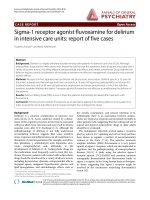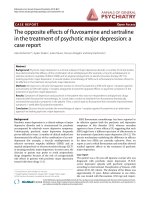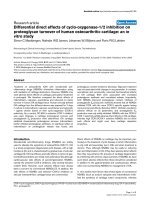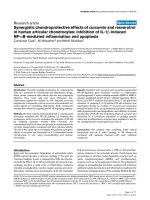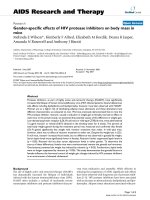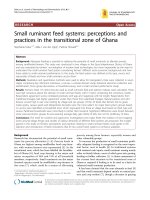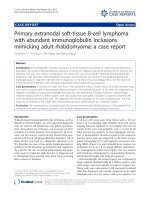Báo cáo y học: "The opposite effects of fluvoxamine and sertraline in the treatment of psychotic major depression: a case report" potx
Bạn đang xem bản rút gọn của tài liệu. Xem và tải ngay bản đầy đủ của tài liệu tại đây (291.23 KB, 3 trang )
Kishimoto et al. Annals of General Psychiatry 2010, 9:23
/>Open Access
CASE REPORT
BioMed Central
© 2010 Kishimoto et al; licensee BioMed Central Ltd. This is an Open Access article distributed under the terms of the Creative Commons
Attribution License ( which permits unrestricted use, distribution, and reproduction in
any medium, provided the original work is properly cited.
Case report
The opposite effects of fluvoxamine and sertraline
in the treatment of psychotic major depression: a
case report
Akira Kishimoto*
1
, Ayako Todani
2
, Junko Miura
1
, Tetsuno Kitagaki
1
and Kenji Hashimoto
3
Abstract
Background: Psychotic major depression is a clinical subtype of major depressive disorder. A number of clinical studies
have demonstrated the efficacy of the combination of an antidepressant (for example, a tricyclic antidepressant or
selective serotonin reuptake inhibitor (SSRI)) and an atypical antipsychotic or electroconvulsive therapy (ECT) in
treating psychotic major depression. In several studies, monotherapy of SSRIs such as fluvoxamine has been shown to
be effective in the treatment of psychotic major depression.
Methods: We report on a 36-year-old Japanese woman in whom fluvoxamine (a SSRI with sigma-1 receptor agonist)
and sertraline (a SSRI with sigma-1 receptor antagonist) showed the opposite effects on psychotic symptoms in the
treatment of psychotic major depression.
Results: Symptoms of depression and psychosis in the patient who was non-respondent to antipsychotic drugs
improved after fluvoxamine monotherapy. At 3 years later, a switch to sertraline from fluvoxamine dramatically
worsened the psychotic symptoms in the patient. Then, a switch back to fluvoxamine from sertraline improved these
symptoms 1 week after fluvoxamine treatment.
Conclusion: Doctors should consider the monotherapy of sigma-1 receptor agonist fluvoxamine as an alternative
approach to treating psychotic major depression.
Background
Psychotic major depression is a clinical subtype of major
depressive disorder and is characterized by psychosis
accompanied by relatively severe depressive symptoms.
Unfortunately, psychotic major depression frequently
proves difficult to treat. A number of clinical studies have
demonstrated the efficacy of the combination of an anti-
depressant (for example, a tricyclic antidepressant or
selective serotonin reuptake inhibitor (SSRI)) and an
atypical antipsychotic or electroconvulsive therapy (ECT)
in treating psychotic major depression. In some cases, the
clinician or patient may prefer to avoid antipsychotic
drugs altogether because of the risk of extrapyramidal
side effects in patients with psychotic major depression
treated with these drugs [1-3].
SSRI fluvoxamine monotherapy has been reported to
be effective against both the psychotic and depressive
symptoms of this disorder [4-8], whereas sertraline
appears to have a lower efficacy [9], suggesting that each
SSRI might have a different spectrum of effectiveness in
the treatment of psychotic major depression [10-12]. The
precise mechanisms underlying the difference in efficacy
for these two SSRIs are currently unknown. Here, we
report a case in which fluvoxamine and sertraline showed
marked opposite effects in the treatment of psychotic
major depression.
Case report
The patient was a 36-year-old Japanese woman who was
diagnosed with psychotic major depression (F-32.3:
severe depressive episode with psychotic symptoms)
according to International Classification of Disease, 10th
edition (ICD-10) criteria. The duration of her illness was
approximately 15 years. Before admission to our clinic,
she was treated with fluvoxamine (150 mg) and risperi-
* Correspondence:
1
Yonago Medical Corporation, Yonago Clinic, Yonago, Tottori, Japan
Full list of author information is available at the end of the article
Kishimoto et al. Annals of General Psychiatry 2010, 9:23
/>Page 2 of 3
done (4 mg) for about 1 year, and her symptoms were
recovered. Then, she was admitted to the clinic due to
delusions of persecution, including 'Everybody hopes that
I return to the home from day care', 'The persons at day
care are annoying me. I am troubling other persons', 'I do
not like eyes of the persons who meet me at the return
from day care. A man comes after me on the way of com-
ing to the clinic', and depression. Risperidone (4 mg) was
also added to the fluvoxamine (100 mg) treatment, but
there no therapeutic effects were observed with respect
to these delusions. The antipsychotic drug perospirone
(12-24 mg) was then added, but it also showed no effect
on the delusions. The fluvoxamine was therefore
increased to 150 mg, and her delusions began to gradu-
ally decrease and finally disappeared completely. After
recovery, risperidone treatment was stopped. Treatment
with fluvoxamine (150 mg) monotherapy was main-
tained, and her condition remained good.
At 2 years after the disappearance of the delusions, the
patient began overeating and oversleeping, as well as
experiencing premenstrual syndrome. The Diagnostic
and Statistical Manual of Mental Disorders, fourth edi-
tion (DSM-IV) criteria for atypical features include mood
reactivity in addition to two of the following symptoms:
overeating, oversleeping, severe fatigue or leaden paraly-
sis, and a history of rejection sensitivity. Therefore, flu-
voxamine (150 mg) was stopped because the diagnosis of
atypical depression was doubted, and the patient was
changed to another SSRI, sertraline (75 mg), as sertraline
has been shown to be effective in the treatment of atypi-
cal depression and premenstrual syndrome [13-15]. At 3
days after the switch to sertraline, the patient suffered
from several delusions such as 'Neighbors kick the wall of
the house at home', 'They talk about me on the TV news',
and 'The environment where I live now is bad'. In addi-
tion, she experienced cenestopathy such as 'I always think
that there are chopsticks in the hole of my nose'. The ser-
traline was therefore stopped and was changed to fluvox-
amine (150 mg). A week after fluvoxamine monotherapy
treatment was given, the above symptoms and experi-
ences rapidly disappeared.
Discussion
Here we report a case showing the opposite effects of flu-
voxamine and sertraline in a female patient with psy-
chotic major depression that was non-respondent to
antipsychotics. In this case, fluvoxamine monotherapy
was effective in the treatment of psychotic major depres-
sion, and the switch to sertraline worsened the psychotic
symptoms in the patient. The mechanisms underlying the
opposite effects of these two SSRIs on the symptoms of a
patient with psychotic major depression are currently
unclear. This case suggests that fluvoxamine is clinically
effective in the treatment of psychotic major depression,
but sertraline may not be clinically useful for psychotic
major depression although a further detailed study is nec-
essary. It is thus likely that doctors should treat very care-
fully for the treatment of psychotic major depression
using SSRI monotherapy.
One possible mechanism may be due to the difference
in the action of these SSRIs at the endoplasmic reticulum
protein sigma-1 receptors. Several pieces of evidence sug-
gest that sigma-1 receptors play a role in the pathophysi-
ology of major depression and in the active mechanisms
of some antidepressants [16-20]. The inhibition constants
(Ki) of fluvoxamine and sertraline at sigma-1 receptors
are 36 nM and 57 nM, respectively [21]. Some recent
studies have suggested that fluvoxamine is a potent ago-
nist at sigma-1 receptors, whereas sertraline may be a
sigma-1 receptor antagonist [18,19,22-24]. A positron
emission tomography study demonstrated that fluvoxam-
ine binds to sigma-1 receptors in the intact human brain
at therapeutic doses [25], suggesting that sigma-1 recep-
tors are involved in the active mechanisms of fluvoxam-
ine [19]. Interestingly, the addition of haloperidol (a
potent sigma-1 receptor antagonist) has been found to
reduce the response rate to fluvoxamine from 69% to
45%, suggesting that haloperidol might antagonize the
sigma-1 receptor activity of fluvoxamine [26]. Based on
all these findings, it has been hypothesized that the
sigma-1 receptors may be implicated in the efficacy of
fluvoxamine for psychotic depression [7,8,10-12]. It
seems that serotonin reuptake inhibition as well as sigma-
1 receptor agonism may be involved in the active mecha-
nism of fluvoxamine, since paroxetine (no affinity at
sigma-1 receptors) has a lesser effect in psychotic major
depression [27]. Although this case study does not clarify
whether sigma-1 receptors are involved in the active
mechanism of fluvoxamine, it is likely that the difference
in the pharmacological actions (agonist or antagonist) of
the two SSRIs at the sigma-1 receptors may have been
related to the mechanisms of the opposite effects of the
two SSRIs in this case. Thus, it seems that the antagonism
of sigma-1 receptors by sertraline may be involved in the
recurrence of psychotic symptoms in this case, although a
further detailed study is necessary.
Another possibility is due to the potent inhibition (Ki =
22 nM for sertraline, Ki = 16,790 nM for fluvoxamine) of
dopamine transporter by sertraline [28]. It is suggested
that the relative potency of sertraline for dopamine trans-
porter inhibition might differentiate its psychopharma-
cology from that of other SSRIs [29]. It is therefore
possible that activation of the dopaminergic system by
the inhibition of dopamine transporter may be involved
in the mechanism of unwanted effects (deterioration of
psychosis) of sertarline in this case, although further
study is necessary.
Kishimoto et al. Annals of General Psychiatry 2010, 9:23
/>Page 3 of 3
Conclusions
This case suggests that the sigma-1 receptor agonist flu-
voxamine could be an alternative approach in treating
psychotic major depression. More detailed randomized,
double-blind studies should be performed to clarify the
role of sigma-1 receptors in the efficacy of fluvoxamine
for psychotic major depression.
Consent
The treatment of the reported case was made according
to standard clinical practice; however written informed
consent was obtained from the patient for publication of
this case report.
Competing interests
The authors declare that they have no competing interests.
Authors' contributions
AK, AT, JM and TK contributed to the clinical and rating evaluations during the
follow-up periods. KH conceived of the study and participated in its study and
coordination. All authors read and approved the final manuscript.
Author Details
1
Yonago Medical Corporation, Yonago Clinic, Yonago, Tottori, Japan,
2
Yakumo
Hospital, Matsue, Shimane, Japan and
3
Division of Clinical Neuroscience, Chiba
University Center for Forensic Mental Health, Chiba, Japan
References
1. Schatzberg AF: New approaches to managing psychotic depression. J
Clin Psychiatry 2003, 64(Suppl 1):19-23.
2. Dannon PN, Lowengrub K, Gonopolski Y, Kotler M: Current and emerging
somatic treatment strategies in psychotic major depression. Expert Rev
Neurother 2006, 6:73-80.
3. Hamoda HM, Osser DN: The Psychopharmacology Algorithm Project at
the Harvard South Shore Program: an update on psychotic depression.
Harv Rev Psychiatry 2008, 16:235-247.
4. Gatti F, Bellini L, Gasperini M, Perez J, Zanardi R, Smeraldi E: Fluvoxamine
alone in the treatment of delusional depression. Am J Psychiatry 1996,
153:414-416.
5. Zanardi R, Franchini L, Gasperini M, Smeraldi E, Perez J: Long-term
treatment of psychotic (delusional) depression with fluvoxamine: an
open pilot study. Int Clin Psychopharmacol 1997, 12:195-197.
6. Zanardi R, Franchini L, Serretti A, Perez J, Smeraldi E: Venlafaxine versus
fluvoxamine in the treatment of delusional depression: a pilot double-
blind controlled study. J Clin Psychiatry 2000, 61:26-29.
7. Furuse T, Hashimoto K: Fluvoxamine monotherapy for psychotic
depression: the potential role of sigma-1 receptors. Ann Gen Psychiatry
2009, 8:26.
8. Shirayama Y, Hashimoto K: A case of psychotic depression treated with
fluvoxamine monotherapy. Clin Psychopharmacol Neurosci 2010,
8:53-54.
9. Simpson GM, El Sheshai A, Rady A, Kingsbury SJ, Fayek M: Sertraline as
monotherapy in the treatment of psychotic and nonpsychotic
depression. J Clin Psychiatry 2003, 64:959-965.
10. Stahl SM: Antidepressant treatment of psychotic major depression:
potential role of the sigma receptor. CNS Spectr 2005, 10:
319-323.
11. Hayashi T, Su TP: Understanding the role of sigma-1 receptors in
psychotic depression. Psychiatric Times 2005, 22:54-63.
12. Ishikawa M, Hashimoto K: The role of sigma-1 receptors in the
pathophysiology of neuropsychiatric diseases. J Receptor Ligand
Channel Res 2010, 3:25-36.
13. Søgaard J, Lane R, Latimer P, Behnke K, Christiansen PE, Nielsen B,
Ravindran AV, Reesal RT, Goodwin DP: A 12-week study comparing
moclobemide and sertraline in the treatment of outpatients with
atypical depression. J Psychopharmacol 1999, 13:406-414.
14. Young SA, Hurt PH, Benedek DM, Howard RS: Treatment of premenstrual
dysphoric disorder with sertraline during the luteal phase: a
randomized, double-blind, placebo-controlled crossover trial. J Clin
Psychiatry 1998, 59:76-80.
15. Dimmock PW, Wyatt KM, Jones PW, O'Brien PM: Efficacy of selective
serotonin-reuptake inhibitors in premenstrual syndrome: a systemic
review. Lancet 2000, 356:1131-1136.
16. Hashimoto K, Ishiwata K: Sigma receptor ligands: possible application as
therapeutic drugs and as radiopharmaceuticals. Curr Pham Des 2006,
12:3857-3876.
17. Hayashi T, Su TP: Sigma-1 receptor chaperones at the ER-
mitochondrion interface regulate Ca
2+
signaling and cell survival. Cell
2007, 131:596-610.
18. Hayashi T, Stahl SM: The sigma-1 receptor and its role in the treatment
of mood disorders. Drugs Future 2009, 34:137-146.
19. Hashimoto K: Sigma-1 receptors and selective serotonin reuptake
inhibitors: clinical implications of their relationship. Cent Nerv Sys
Agents Med Chem 2009, 9:197-204.
20. Hindmarch I, Hashimoto K: Cognition and depression: the effects of
fluvoxamine, a sigma-1 receptor agonist, reconsidered. Hum
Psychopharmacol Clin Exp 2010, 25:193-200.
21. Narita N, Hashimoto K, Tomitaka S, Minabe Y: Interactions of selective
serotonin reuptake inhibitors with subtypes of sigma receptors in rat
brain. Eur J Pharmacol 1996, 307:117-119.
22. Hashimoto K, Fujita Y, Iyo M: Phencyclidine-induced cognitive deficits in
mice are improved by subsequent subchronic administration of
fluvoxamine: role of sigma-1 receptors. Neuropsychopharmacology
2007, 32:514-521.
23. Nishimura T, Ishima T, Iyo M, Hashimoto K: Potentiation of nerve growth
factor-induced neurite outgrowth by fluvoxamine: role of sigma-1
receptors, IP
3
receptors and cellular signaling pathways. PLoS ONE
2008, 3:e2558.
24. Ishima T, Fujita Y, Kohno M, Kunitachi S, Horio M, Takatsu M, Minase T,
Tanibuchi Y, Hagiwara H, Iyo M, Hashimoto K: Improvement of
phencyclidine-induced cognitive deficits in mice by subsequent
subchronic administration of fluvoxamine, but not sertraline. Open
Clin Chem J 2009, 2:7-11.
25. Ishikawa M, Ishiwata K, Ishii K, Kimura Y, Sakata M, Naganawa M, Oda K,
Miyatake R, Fujisaki M, Shimizu E, Shirayama Y, Iyo M, Hashimoto K: High
occupancy of sigma-1 receptors in the human brain after single oral
administration of fluvoxamine: a positron emission tomography study
using [
11
C]SA4503. Biol Psychiatry 2007, 62:878-883.
26. Bellini L, Gasperini F, Gatti F, Franchini L, Smeraldi E: A double-blind study
with fluvoxamine versus desipramine combined with placebo or
haloperidol in delusional depression. In Critical Issues in the Treatment of
Affective Disorders Edited by: Brunello N, Langer SZ, Mendlewicz J, Racagni
G. Basel, Switzerland: Karger; 1994.
27. Zanardi R, Franchini L, Gasperini M, Perez J, Smeraldi E: Double-blind
controlled trial of sertraline versus paroxetine in the treatment of
delusional depression. Am J Psychiatry 1996, 153:1631-1633.
28. Owens MJ, Knight DL, Nemeroff CB: Second-generation SSRIs: human
monoamine transporter binding profile of escitalopram and R-
fluoxetine. Biol Psychiatry 2001, 50:345-50.
29. Goodnick PJ, Goldstein BJ: Selective serotonin reuptake inhibitors in
affective disorders - I. Basic pharmacology. J Psychopharmacol 1998,
12(Suppl B):S5-S20.
doi: 10.1186/1744-859X-9-23
Cite this article as: Kishimoto et al., The opposite effects of fluvoxamine and
sertraline in the treatment of psychotic major depression: a case report
Annals of General Psychiatry 2010, 9:23
Received: 22 April 2010 Accepted: 21 May 2010
Published: 21 May 2010
This article is available from: 2010 Kishimoto et al; l icensee BioMed Central Ltd. This is an Open Access article distributed under the terms of the Creative Commons Attribution License ( ), which permits unrestricted use, distribution, and reproduction in any medium, provided the original work is properly cited.Annals of General Psychiatry 2010, 9:23

